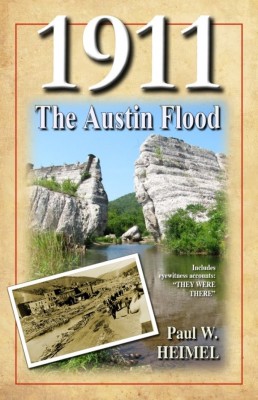Paul Heimel’s new Book ‘1911: The Austin Flood’ now Available
 COUDERSPORT, PA – A century after a massive concrete dam gave way, nearly destroying the town of Austin, Pennsylvania, and claiming upwards of 80 lives, a new book has been released that reveals the cause of the disaster as only an investigative journalist could.
COUDERSPORT, PA – A century after a massive concrete dam gave way, nearly destroying the town of Austin, Pennsylvania, and claiming upwards of 80 lives, a new book has been released that reveals the cause of the disaster as only an investigative journalist could.
Knox Books has released “1911: The Austin Flood,” a 300-page trade paperback that includes upwards of 200 photographs, most of them never seen by the public. The book, which is timed to coincide with the centennial observance of the traffic flood of Sept. 30, 1911, is a labor of love for Potter County author Paul W. Heimel, a former reporter whose previous local history works include books on crimefighter Eliot Ness and Norwegian violin legend Ole Bull.
“For more than a half-century, a very thoroughly documented and well-written book by Marie Kathern Nuschke, titled ‘The Dam That Could Not Break,’ has stood as the authoritative account of the flood,” Heimel said. “It is with great respect for the Nuschke family that I have been building on that foundation for the better part of a decade in order to complete this book in time for the centennial.”
Bayless Pulp and Paper Company had the dam built in 1909 to help meet its massive paper mill’s demand for a steadier water supply. The 50-foot-high wall was failing just two months after it was completed, but the Bayless company failed to address its deficiencies. Heavy rains washed into the valley behind the dam in September 1911, causing the dam to fill to capacity and give way. Austin, a progressive and prosperous community born in the early days of the region’s lumber era, lost most of its homes, businesses, industrial plants and churches.
The town has never fully recovered but, as Heimel points out in his book, Austin has earned its reputation as “the town too tough to die” by surviving floods, fires, economic recession and other challenges.
“This is a disaster that could have been prevented, if warning signs had been heeded,” Heimel wrote. In his research, he came across a series of letters between company owner George Bayless and his chief engineer, T. Chalkley Hatton, confirming the former’s insistence on cutting costs during construction. “Mr. Bayless, in effect, sabotaged his own dam,” Heimel wrote.
At the same time, the author points out that the record rainfall that struck in September 1911 couldn’t have been predicted by anyone. Bayless was aware of the dam’s deficiencies and had taken steps to prevent the lake behind it from growing too deep and exerting too much pressure on the concrete edifice.
In a chapter titled, “Who’s to Blame?,” Heimel cites engineering reports confirming that the dam’s foundation was not laid deeply enough into the bedrock. Once water was allowed to infiltrate the dam’s base, slippage took place and – given the amount of pressure exerted by a full impoundment – failure was inevitable.
The tragedy could have been avoided if Bayless would have accepted engineer Hatton’s recommendation that a cut-off wall be built just upstream from the dam to divert any potential infiltration.
Also included in the book are 38 eyewitness accounts of the flood, in the survivors’ own words, and a list of who died and how. Some of the accounts are chilling, including the story told by Mary Blaitz, a Bayless employee who persuaded a co-worker to chop off her leg with an ax after she became pinned between two grinding stones; and the recollections of young Madge Nelson, who climbed under the covers of her bed and rode on the wave’s crest for more than a mile before she was pulled to safety.
Heimel’s research was supported by the Potter County Historical Society, Austin Dam Memorial Association, E. O. Austin Historical Society and the National Society of Professional Engineers.
Copies of “1911: The Austin Flood” are available online (credit card or PayPal accepted) at knoxbooks.net; at the Leader-Enterprise office and Olga’s Café, both in Coudersport; the E. O. Austin Historical Museum and Perry’s Country Store, both in Austin; Copy Katz/Endeavor Media, Emporium; Tioga Publishing/Wellsboro Gazette, Wellsboro; and other retailers to be announced; or directly through Knox Books by calling 814-558-7107.
